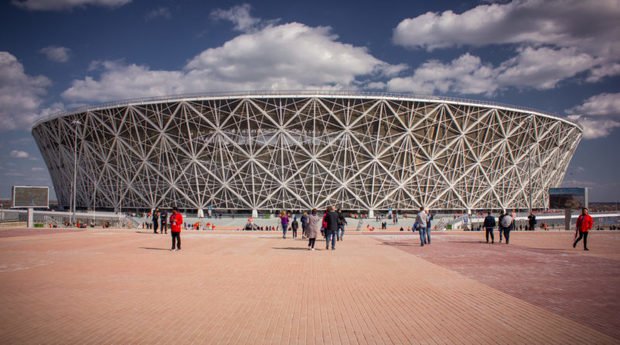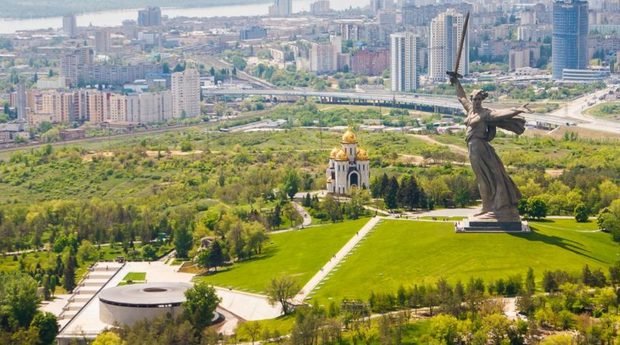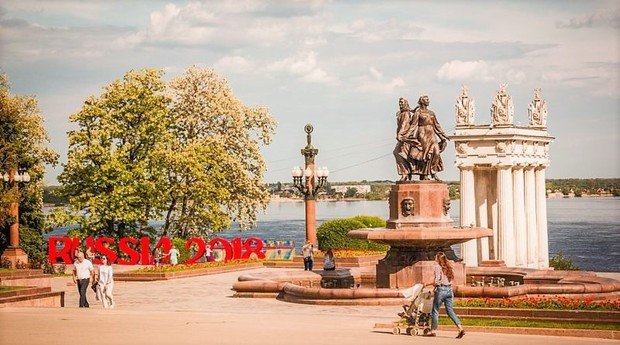Volgograd: 'Stalin city', Motherland Calls and Soviet cuisine dishes in restaurants
Matches
From 18 to 28 June, Volgograd will host four 2018 FIFA WC group stage matches. On 18 June, England will play here with Tunisia, the squads of Nigeria and Iceland will be on the pitch on 22 June, Saudi Arabia and Egypt (the teams from Russia's Group A) will fight on 25 June, and the national team of Poland will play against the national team of Japan on 28 June. There won't be play-off matches in Volgograd.
Stadium
Volgograd Arena erected in the place of the former Central Stadium, which was demolished due to non-compliance with international standards, will host the WC in Volgograd. The construction of the new stadium began in 2014, its area is equal to 122,000 square metres, while the capacity reaches 45,000 spectators.
The arena is located in the city's historical centre, on the bank of the Volga River. A historical ensemble dedicated to the Great Patriotic War is next to it – a monument of the Heroes of the Battle of Stalingrad. One can see the central element of this ensemble – the monument Motherland Calls – standing near the stadium. We should note the stadium was tested by the Russian Cup final almost one month to the WC, on 9 May: Tosno from Leningrad Oblast won Avangard from Kursk 2-1 at the stadium. Even if the 15 th team of the Russian Football Premier League and the 11th team of the Football National League, a considerable number of fans visited the match – 40,000 people.

Stadium stop
Volgograd has two long streets crossing the whole city. One can easily get to the stadium on them.
To reach Volgograd Arena from the railway station, you can take Share Taxi 123 or Trolleybus 8: according to God2018 portal, it will take just 15 minutes without traffic jams. Share Taxi 1с, 2с, 3с, 15с, 10а, 15а, 100, 123, 160, 260, 36, 53, 57, 77 and 84, Bus 37 and Trolleybus 1, 12, 8 and 8а go to the bus stop Central Stadium from the main street of the city – Lenin Prospekt.
In addition, one can go to the stadium by tramway or taxi (Uber doesn't operate in the city, but there such local services as Vezyot, Navigator or Urban Taxi).
Where to stay
Volgograd is one of the leaders among Russia cities in number of qualified hotels that are ready to welcome 2018 WC guests. According to Komsomolskaya Pravda newspaper, 311 collective accommodation places have been registered in Volgograd this spring: inns, hotels, health centres, recreation bases, hostels, guest houses, university residence halls – 113 of which are located in the city itself. Nevertheless, popular inns and hotels don't have vacant rooms on the match days.
According to the data published on Booking.com, in the middle of May, the city's guests had a chance to book a bed in some Volgograd hostels for a reasonable price – for about 3,000 rubles per night. Different apartments are also leased: the price of rent per night is from 8,000 rubles. However, there aren't so many 'adequate' options – many hosts offer quite unpleasant prices at 40, 100 and even 270,000 rubles per night.
On Airbnb, it's possible to find flats in the city, the price fluctuates from 3,000 to 150,000 rubles per night (the last tag is for a five-bedroomed flat). We should also note that an inexpensive option to stay can be found in hotels of the city of Volzhsky, which is about 30 km far from Volgograd.

Sightseeing points
The Battle of Stalingrad in Volgograd (Stalingrad from 1925 to 1961) was a life-changing moment in WWII. People had to erect the city from scratch after the war. A big monument on Mamayev Kurgan is probably its main sightseeing point. One should visit it to see a group of monuments To Heroes of the Battle of Stalingrad as well as its central element – the Motherland Calls statue erected in 1967 (which was the highest statue in the world then). Mamayev Kurgan has several common and individual graves where the ashes of more than 35,000 defenders of Stalingrad lie.
The urban embankment is a point of attraction for citizens and guests of Volgograd. It consists of two terraces – upper (with residential districts, parks and squares) and lower (it's located almost near the water). Volgodonskaya Street, which is also called the old city's island, is another interesting place to go for a walk. It appeared as early as late the 18 th century, and today the whole architectural ensemble is a cultural heritage site. One can also visit the main square of the city – the Square of Fallen Fighters or go through Mira Street, which ends with the building of the urban Planetarium that resembles a cathedral.

The building of the central department store is another symbol of the city as well as the symbol of victory in the Battle of Stalingrad. Now Memory museum is located in the department store's underground. The Volgograd elevator and a monument to its defenders (Monument to the North Sea Fleet Sailors) is another interesting point. People should also pay attention to the city's Kirov District where a unique building of the 1930s has survived. If you have the time, you can go to the Volga-Akhtubinskaya Floodplain whose flora and fauna are considerably different from that of the surrounding arid steppe environment.
Where to eat
To have a snack inexpensively, you can go to Konfetki-baranochki local chain of canteens or Schastie Yest! urban public catering. Russian and Soviet cuisines can be found in Marusya and Onegin restaurants.
For Italian cuisine, you can go to Basilico or Rimini. Eastern cuisine is present in the menu of restaurants Shafran, Khinkalnaya, Chito Gvrito, and German cuisine is in Bamberg.
Fans of meat, beer, football and live music can have a rest in Poneslos bar, HARAT'S chain of Irish pubs or traditional beer restaurant Paulaner.